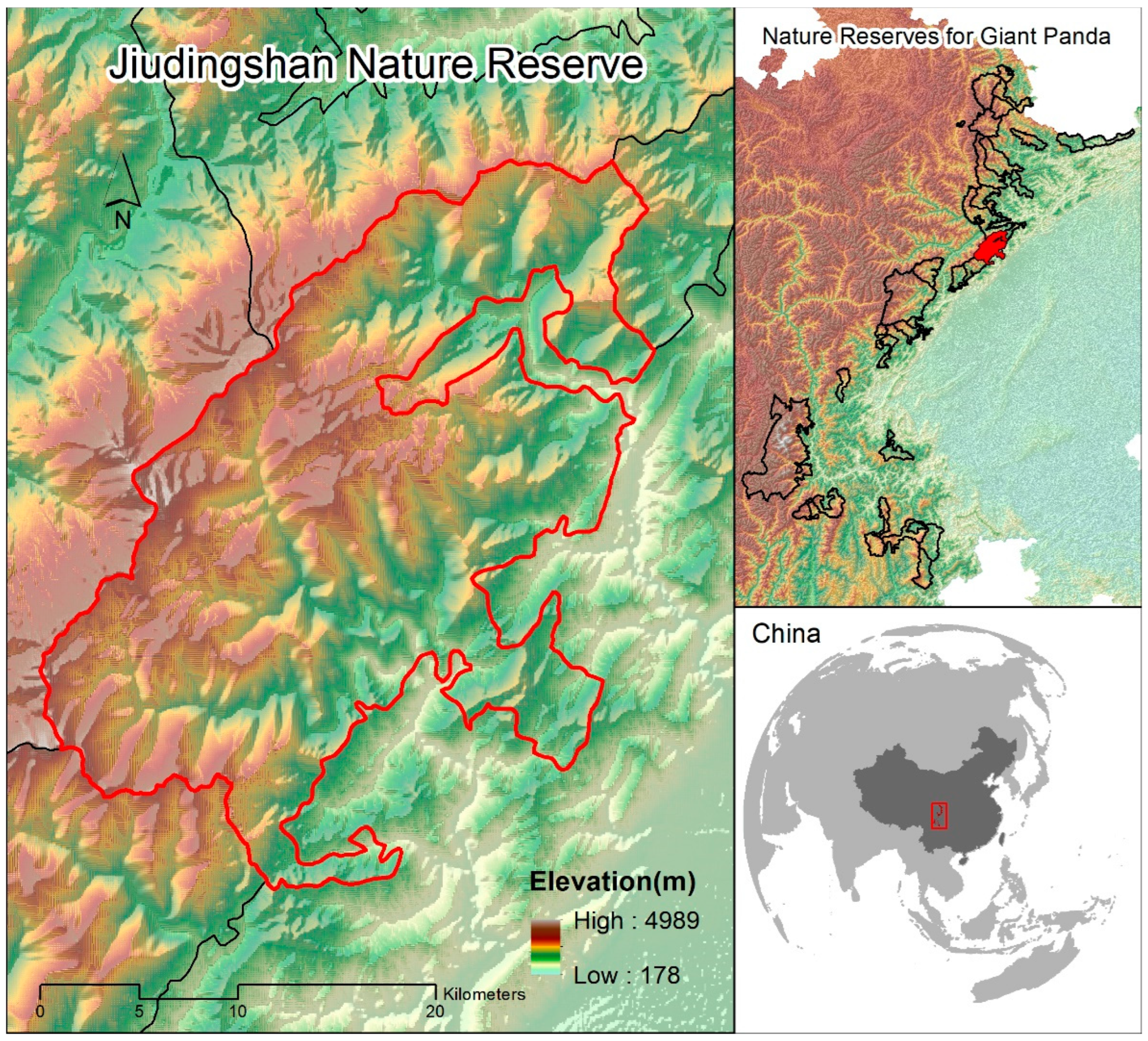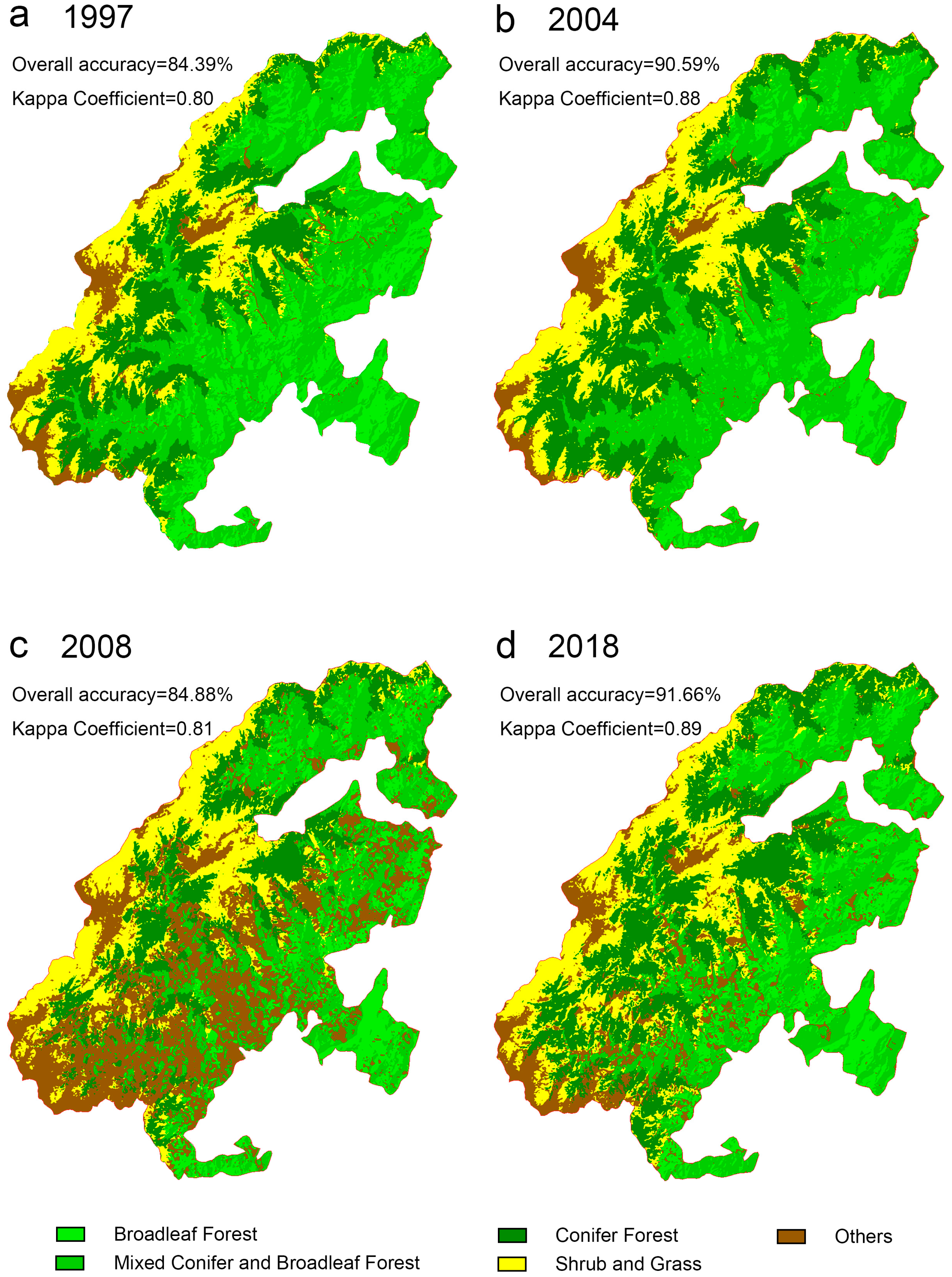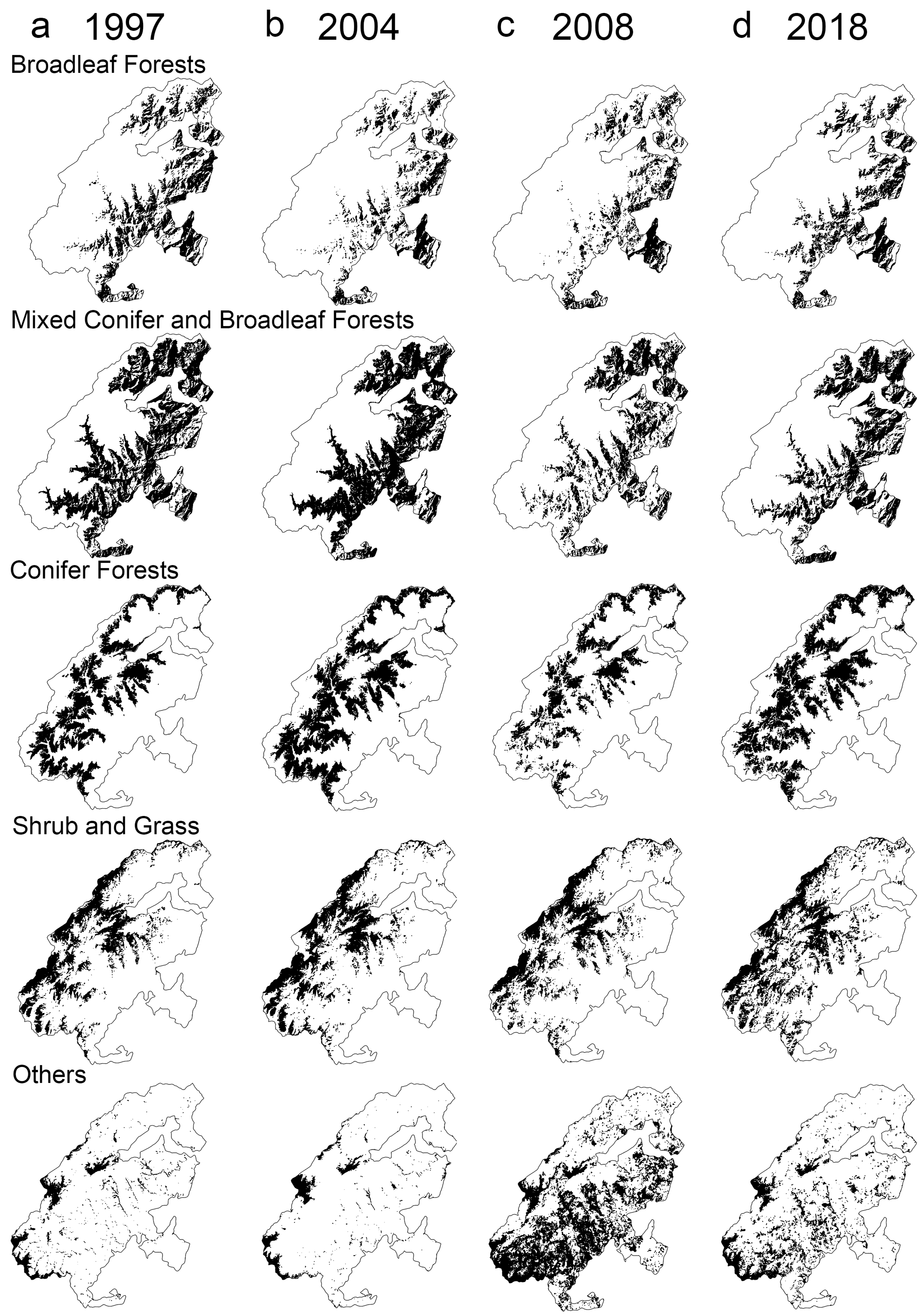Spatio-Temporal Evolution of Forest Landscape in China’s Giant Panda National Park: A Case Study of Jiudingshan Nature Reserve
Abstract
:1. Introduction
2. Study Area
3. Data and Methods
3.1. Input Layer and Output Layer
3.2. Configuration of Parameters and Software
3.3. Landscape Change Monitoring and Landscape Indices
4. Results
4.1. MLP Mapped Land Use/Cover Patterns for 20 Years
4.2. Habitat Change Detection of JNR
4.3. Patterns of Landscape Indices
5. Discussion
5.1. MLP: A Powerful Classification Model
5.2. Dynamic Change of Forest Landscape in JNR
6. Conclusions
Author Contributions
Funding
Data Availability Statement
Conflicts of Interest
References
- Laurance, W.F.; Lovejoy, T.E.; Vasconcelos, H.L.; Bruna, E.M.; Didham, R.K.; Stouffer, P.C.; Gascon, C.; Bierregaard, R.O.; Laurance, S.G.; Sampaio, E. Ecosystem decay of Amazonian forest fragments: A 22-year investigation. Conserv. Biol. 2002, 16, 605–618. [Google Scholar] [CrossRef] [Green Version]
- Mollicone, D.; Achard, F.; Federici, S.; Eva, H.D.; Grassi, G.; Belward, A.; Raes, F.; Seufert, G.; Stibig, H.-J.; Matteucci, G. An incentive mechanism for reducing emissions from conversion of intact and non-intact forests. Clim. Change 2007, 83, 477–493. [Google Scholar] [CrossRef]
- Stolton, S.; Shadie, P.; Dudley, N. IUCN WCPA best practice guidance on recognising protected areas and assigning management categories and governance types. In Best Practice Protected Area Guidelines Series; IUCN: Gland, Switzerland, 2013; Volume 21, pp. 1–31. [Google Scholar]
- Sellars, R.W. Preserving Nature in the National Parks: A History: With A New Preface and Epilogue; Yale University Press: New Haven, CT, USA, 2009. [Google Scholar]
- European Environment Agency. Protected Areas in Europe—An Overview; No. 5; European Environment Agency: Copenhagen, Denmark, 2012; p. 130.
- Hull, V.; Zhang, J.; Huang, J.; Zhou, S.; Vina, A.; Shortridge, A.; Li, R.; Liu, D.; Xu, W.; Ouyang, Z.; et al. Habitat Use and Selection by Giant Pandas. PLoS ONE 2016, 11, e0162266. [Google Scholar] [CrossRef] [PubMed]
- Hu, J.; Schaller, G.; Pan, W.; Zhu, J. The Giant Panda of Wolong; Sichuan Scientific and Technological Publishing House: Chengdu, China, 1985. (In Chinese) [Google Scholar]
- Loucks, C.J.; Lü, Z.; Dinerstein, E.; Wang, H.; Olson, D.M.; Zhu, C.; Wang, D. Giant Pandas in a Changing Landscape. Science 2001, 294, 1465. [Google Scholar] [CrossRef] [Green Version]
- Bearer, S.; Linderman, M.; Huang, J.; An, L.; He, G.; Liu, J. Effects of fuelwood collection and timber harvesting on giant panda habitat use. Biol. Conserv. 2008, 141, 385–393. [Google Scholar] [CrossRef]
- Reid, D.G.; Jinchu, H. Giant Panda Selection Between Bashania fangiana Bamboo Habitats in Wolong Reserve, Sichuan, China. J. Appl. Ecol. 1991, 28, 228–243. [Google Scholar] [CrossRef]
- Liu, X.; Cheng, X.; Skidmore, A.K. Potential solar radiation pattern in relation to the monthly distribution of giant pandas in Foping Nature Reserve, China. Ecol. Model. 2011, 222, 645–652. [Google Scholar] [CrossRef]
- Liu, J.; Ouyang, Z.; Taylor, W.W.; Groop, R.; Tan, Y.; Zhang, H. A Framework for Evaluating the Effects of Human Factors on Wildlife Habitat: The Case of Giant Pandas. Conserv. Biol. 1999, 13, 1360–1370. [Google Scholar] [CrossRef]
- Swaisgood, R.; Wang, D.; Wei, F. Ailuropoda melanoleuca: The IUCN Red List of Threatened Dpecies. International Union for Conservation of Nature. T712A45033386. 2016. Available online: http://www.iucnredlist.org/details/712/0 (accessed on 29 January 2022).
- Liu, J.; Li, S.; Ouyang, Z.; Tam, C.; Chen, X. Ecological and socioeconomic effects of China’s policies for ecosystem services. Proc. Natl. Acad. Sci. USA 2008, 105, 9477–9482. [Google Scholar] [CrossRef]
- Li, Y.; Vina, A.; Yang, W.; Chen, X.; Zhang, J.; Ouyang, Z.; Liang, Z.; Liu, J. Effects of Conservation Policies on Forest Cover Change in Giant Panda Habitat Regions, China. Land Use Policy 2013, 33, 42–53. [Google Scholar] [CrossRef] [Green Version]
- Kang, D. A review of the impacts of four identified major human disturbances on the habitat and habitat use of wild giant pandas from 2015 to 2020. Sci. Total Environ. 2021, 763, 142975. [Google Scholar] [CrossRef]
- Xu, Y.; Liu, R.; Xue, C.; Xia, Z. Ecological Sensitivity Evaluation and Explanatory Power Analysis of the Giant Panda National Park in China. Ecol. Indic. 2023, 146, 109792. [Google Scholar] [CrossRef]
- Huang, Q.; Fei, Y.; Yang, H.; Gu, X.; Songer, M. Giant Panda National Park, a step towards streamlining protected areas and cohesive conservation management in China. Glob. Ecol. Conserv. 2020, 22, e00947. [Google Scholar] [CrossRef]
- Kang, D.; Li, J. Premature downgrade of panda’s status. Science 2016, 354, 295. [Google Scholar] [CrossRef]
- Liu, J. Promises and perils for the panda. Science 2015, 348, 642. [Google Scholar] [CrossRef]
- Xu, W.; Vina, A.; Kong, L.; Pimm, S.L.; Zhang, J.; Yang, W.; Xiao, Y.; Zhang, L.; Chen, X.; Liu, J.; et al. Reassessing the conservation status of the giant panda using remote sensing. Nat. Ecol. Evol. 2017, 1, 1635–1638. [Google Scholar] [CrossRef]
- Swaisgood, R.R.; Wang, D.; Wei, F. Panda Downlisted but not Out of the Woods. Conserv. Lett. 2018, 11, e12355. [Google Scholar] [CrossRef] [Green Version]
- Cui, P.; Chen, X.-Q.; Zhu, Y.-Y.; Su, F.-H.; Wei, F.-Q.; Han, Y.-S.; Liu, H.-J.; Zhuang, J.-Q. The Wenchuan Earthquake (May 12, 2008), Sichuan Province, China, and resulting geohazards. Nat. Hazards 2009, 56, 19–36. [Google Scholar] [CrossRef]
- der Hilst, B. A geological and geophysical context for the Wenchuan earthquake of 12 May 2008, Sichuan, People’s Republic of China. GSA Today 2008, 18, 5. [Google Scholar]
- Wang, D.; Li, S.; Sun, S.; Wang, H.; Chen, A.; Li, S.; Li, J.; Lu, Z. Turning earthquake disaster into long-term benefits for the panda. Conserv. Biol. 2008, 22, 1356–1360. [Google Scholar] [CrossRef] [PubMed]
- Xu, W.; Wang, X.; Ouyang, Z.; Zhang, J.; Li, Z.; Xiao, Y.; Zheng, H. Conservation of giant panda habitat in South Minshan, China, after the May 2008 earthquake. Front. Ecol. Environ. 2009, 7, 353–358. [Google Scholar] [CrossRef]
- Wulder, M.A.; Roy, D.P.; Radeloff, V.C.; Loveland, T.R.; Anderson, M.C.; Johnson, D.M.; Healey, S.; Zhu, Z.; Scambos, T.A.; Pahlevan, N.; et al. Fifty years of Landsat science and impacts. Remote Sens. Environ. 2022, 280, 113195. [Google Scholar] [CrossRef]
- Hemati, M.; Hasanlou, M.; Mahdianpari, M.; Mohammadimanesh, F. A Systematic Review of Landsat Data for Change Detection Applications: 50 Years of Monitoring the Earth. Remote Sens. 2021, 13, 2869. [Google Scholar] [CrossRef]
- Wulder, M.A.; White, J.C.; Loveland, T.R.; Woodcock, C.E.; Belward, A.S.; Cohen, W.B.; Fosnight, E.A.; Shaw, J.; Masek, J.G.; Roy, D.P. The global Landsat archive: Status, consolidation, and direction. Remote Sens. Environ. 2016, 185, 271–283. [Google Scholar] [CrossRef] [Green Version]
- Liu, X.; Wu, P.; Shao, X.; Songer, M.; Cai, Q.; Zhu, Y.; He, X. Spatiotemporally monitoring forest landscape for giant panda habitat through a high learning-sensitive neural network in Guanyinshan Nature Reserve in the Qinling Mountains, China. Environ. Earth Sci. 2017, 76, 589. [Google Scholar] [CrossRef]
- Satir, O.; Erdogan, M.A. Monitoring the land use/cover changes and habitat quality using Landsat dataset and landscape metrics under the immigration effect in subalpine eastern Turkey. Environ. Earth Sci. 2016, 75, 1118. [Google Scholar] [CrossRef]
- Rumelhart, D.E.; Hinton, G.E.; Williams, R.J. Learning internal representations by error propagation. In Parallel Distributed Processing: Explorations in the Microstructure of Cognition; Rumelhart, D.E., McClelland, J.L., the PDP Research Group, Eds.; MIT Press: Cambridge, MA, USA, 1986; pp. 318–362. [Google Scholar]
- Benediktsson, J.A.; Swain, P.H.; Ersoy, O.K. Neural network approaches versus statistical methods in classification of multisource remote sensing data. In Proceedings of the IEEE Transactions on Geoscience and Remote Sensing, Vancouver, BC, Canada, 10–14 July 1989. [Google Scholar] [CrossRef]
- Bischof, H.; Schneider, W.; Pinz, A.J. Multispectral classification of Landsat-images using neural networks. IEEE Trans. Geosci. Remote Sens. 1992, 30, 482–490. [Google Scholar] [CrossRef]
- Gopal, S.; Woodcock, C. Remote sensing of forest change using artificial neural networks. IEEE Trans. Geosci. Remote Sens. 1996, 34, 398–404. [Google Scholar] [CrossRef]
- Xu, P.; Fang, W.; Zhou, T.; Zhao, X.; Luo, H.; Hendrey, G.; Yi, C. Spatial Upscaling of Tree-Ring-Based Forest Response to Drought with Satellite Data. Remote Sens. 2019, 11, 2344. [Google Scholar] [CrossRef] [Green Version]
- Brown, M.E.; Pinzón, J.E.; Didan, K.; Morisette, J.T.; Tucker, C.J. Evaluation of the consistency of long-term NDVI time series derived from AVHRR, SPOT-vegetation, SeaWiFS, MODIS, and Landsat ETM+ sensors. IEEE Trans. Geosci. Remote Sens. 2006, 44, 1787–1793. [Google Scholar] [CrossRef]
- Pinty, B.; Verstraete, M.M. GEMI: A non-linear index to monitor global vegetation from satellites. Vegetatio 1992, 101, 15–20. [Google Scholar] [CrossRef]
- Min, Z.; Hong-gui, L.; BO, F.; Xiao-gang, Y.; Xiong, Z.; Zu-ji, Z. Diversity Survey on Mammals Resources in Jiudingshan Nature Reserve of Sichuan Province. J. Sichuan For. Sci. Technol. 2015, 36, 25–29. [Google Scholar]
- Zheng, X.; Li, B.; Jiang, G.; Wang, Z. The community structure of small mammals in Jiudingshan Nature Reserve, Sichuan. J. Sichuan For. Sci. Technol. 2009, 30, 69–71. [Google Scholar]
- State Forestry Administration. The 3rd National Survey Report on Giant Panda in China; Science Press: Beijing, China, 2006.
- Sichuan Forestry Department. The 4th Survey Report on Giant Panda in Sichuan Province; Sichuan Science and Technology Press: Chengdu, China, 2015.
- Zhao, M.; Yu, X.; Zheng, X.; Wang, Z.; Ji, X.; Feng, B. Floristic classification of plant in Jiuding Mountain Nature Reserve in Sichuan Province. J. For. Eng. 2011, 25, 44–46. [Google Scholar] [CrossRef]
- Brehaut, L.; Danby, R.K. Inconsistent relationships between annual tree ring-widths and satellite-measured NDVI in a mountainous subarctic environment. Ecol. Indic. 2018, 91, 698–711. [Google Scholar] [CrossRef]
- Zhang, C.; Wu, S.; Zhao, D.; Guo, Q.; Peng, P. 20 Years of Evolutionary Analysis of Giant Panda Habitat Using Ecological Landscape Patterns of Xiaohegou Nature Reserve. Pol. J. Environ. Stud. 2015, 24, 1401–1411. [Google Scholar] [CrossRef]
- Tang, P.; Chen, F.; Guo, H.; Tian, B.; Wang, X.; Ishwaran, N. Large-Area Landslides Monitoring Using Advanced Multi-Temporal InSAR Technique over the Giant Panda Habitat, Sichuan, China. Remote Sens. 2015, 7, 8925–8949. [Google Scholar] [CrossRef] [Green Version]
- Jiang, W.-G.; Jia, K.; Wu, J.-J.; Tang, Z.-H.; Wang, W.-J.; Liu, X.-F. Evaluating the Vegetation Recovery in the Damage Area of Wenchuan Earthquake Using MODIS Data. Remote Sens. 2015, 7, 8757–8778. [Google Scholar] [CrossRef] [Green Version]
- Liu, X.; Jiang, W.; Li, J.; Wang, W. Evaluation of the Vegetation Coverage Resilience in Areas Damaged by the Wenchuan Earthquake Based on MODIS-EVI Data. Sensors 2017, 17, 259. [Google Scholar] [CrossRef] [Green Version]
- Fan, X.; Domènech, G.; Scaringi, G.; Huang, R.; Xu, Q.; Hales, T.C.; Dai, L.; Yang, Q.; Francis, O. Spatio-temporal evolution of mass wasting after the 2008 Mw 7.9 Wenchuan earthquake revealed by a detailed multi-temporal inventory. Landslides 2018, 15, 2325–2341. [Google Scholar] [CrossRef]
- Mas, J.F.; Flores, J.J. The application of artificial neural networks to the analysis of remotely sensed data. Int. J. Remote Sens. 2008, 29, 617–663. [Google Scholar] [CrossRef]
- Mas, J. Mapping land use/cover in a tropical coastal area using satellite sensor data, GIS and artificial neural networks. Estuar. Coast. Shelf Sci. 2004, 59, 219–230. [Google Scholar] [CrossRef]
- Paola, J.D.; Schowengerdt, R.A. A detailed comparison of backpropagation neural network and maximum-likelihood classifiers for urban land use classification. IEEE Trans. Geosci. Remote Sens. 1995, 33, 981–996. [Google Scholar] [CrossRef]
- Liu, X. Mapping and Modelling the Habitat of Giant Pandas in Foping Nature Reserve, China; Wageningen University and Research: Wageningen, The Netherlands, 2001. [Google Scholar]
- Zhao, D.; Wang, J.; Chen, W.; Liu, X.a.; Zhang, C.; Peng, P. How Potassium Content in Soil Shapes Giant Panda Distribution. Pol. J. Environ. Stud. 2018, 28, 973–979. [Google Scholar] [CrossRef] [PubMed]
- Kong, L.; Xu, W.; Zhang, L.; Gong, M.; Xiao, Y.; Ouyang, Z. Habitat conservation redlines for the giant pandas in China. Biol. Conserv. 2017, 210, 83–88. [Google Scholar] [CrossRef]
- Yu, H.; Zhao, Y.; Ma, Y.; Sun, Y.; Zhang, H.; Yang, S.; Luo, Y. A remote sensing-based analysis on the impact of Wenchuan Earthquake on the core value of World Nature Heritage Sichuan Giant Panda Sanctuary. J. Mt. Sci. 2011, 8, 458. [Google Scholar] [CrossRef]
- Sun, X.-f.; Yuan, L.-g.; Zhou, Y.-z.; Shao, H.-y.; Li, X.-f.; Zhong, P. Spatiotemporal change of vegetation coverage recovery and its driving factors in the Wenchuan earthquake-hit areas. J. Mt. Sci. 2021, 18, 2854–2869. [Google Scholar] [CrossRef]
- Zhang, J.; Hull, V.; Huang, J.; Yang, W.; Zhou, S.; Xu, W.; Huang, Y.; Ouyang, Z.; Zhang, H.; Liu, J. Natural recovery and restoration in giant panda habitat after the Wenchuan earthquake. For. Ecol. Manag. 2014, 319, 1–9. [Google Scholar] [CrossRef]
- Kou, C.; Xu, Y.-Y.; Ke, C.-Q.; He, Y.-T. Impact of Wenchuan earthquake on the giant panda habitat in Wolong National Nature Reserve, China. J. Appl. Remote Sens. 2014, 8, 083507. [Google Scholar] [CrossRef]
- Lu, T.; Shi, F.; Sun, G.; Luo, Y.; Wang, Q.; Wu, Y.; Wu, N. Reconstruction of the Wenchuan Earthquake-Damaged Ecosystems: Four Important Questions. Chin. J. Appplied Environ. Biol. 2010, 16, 301–304. [Google Scholar] [CrossRef]
- Ma, B.; Lei, S.; Qing, Q.; Wen, Y. Should the Endangered Status of the Giant Panda Really Be Reduced? The Case of Giant Panda Conservation in Sichuan, China. Animals 2018, 8, 69. [Google Scholar] [CrossRef] [PubMed] [Green Version]





| Index | Formula | Description |
|---|---|---|
| Number of patches (NP) | NP = N | The total number of patches in the landscape |
| Patch density (PD) | The ni is type i of patch in landscape containing a number of patches; The A is total area of the landscape; N is total number of patches. | |
| Largest patch index (LPI) | The area of patch “ij” is aij; A is total area of the landscape. | |
| Landscape shape index (LSI) | The ei is the patch type i’s total length of the edge; the minei is the minimum possible values for ei; the E is the landscape’s total edge length; the minE is the minimum possible values for E. | |
| Mean nearest neighbor distance (MNN) | The hij is the mean distance (m) from patch ij to the nearest neighboring patch of each type of landscape; N′ is the mean number of patches which have nearest neighboring in each type of landscape. | |
| Contagion (CONTAG) | The Pi in landscape is the area of the proportion of patch type i; the gik is node number based on the method of double between patch type I; and patch type k; the m is the patch type number in landscape. | |
| Landscape division index (DIVISION) | The aij is the area of patch ij; the m is the numbers of landscape type; n is the numbers of patches in each type. | |
| Shannon’s diversity index (SHDI) | The pi in landscape is the area of the proportion of patch type i; m is the patch type number in the landscape. | |
| Shannon’s evenness index (SHEI) | The pi in landscape is the area of the proportion of patch type i; the m is patch type number in landscape. |
| Land Use/Cover Type | 1997 | 2004 | 2008 | 2018 | ||||
|---|---|---|---|---|---|---|---|---|
| Area (ha) | % | Area (ha) | % | Area (ha) | % | Area (ha) | % | |
| Broadleaf forest | 10,943 | 18.82 | 6970 | 11.99 | 7217 | 12.41 | 8640 | 14.86 |
| Mixed conifer and broadleaf forest | 20,901 | 35.95 | 21,516 | 37.00 | 12,528 | 21.55 | 14,988 | 25.78 |
| Conifer forest | 12,798 | 22.01 | 16,114 | 27.71 | 9741 | 16.75 | 15,496 | 26.65 |
| Shrub and grass | 9996 | 17.19 | 10,683 | 18.37 | 9992 | 17.18 | 11,609 | 19.97 |
| Others | 3506 | 6.03 | 2862 | 4.92 | 18,666 | 32.10 | 7412 | 12.75 |
| Year | NP | PD | LPI | LSI | MNN | CONTAG | DIVISION | SHDI | SHEI |
|---|---|---|---|---|---|---|---|---|---|
| 1997 | 3210 | 5.52 | 16.20 | 35.40 | 161.76 | 43.09 | 0.9529 | 1.49 | 0.9241 |
| 2004 | 2767 | 4.76 | 21.59 | 30.30 | 168.39 | 46.13 | 0.8936 | 1.44 | 0.893 |
| 2008 | 5333 | 9.17 | 17.83 | 44.61 | 135.10 | 37.69 | 0.9538 | 1.56 | 0.9671 |
| 2018 | 4510 | 7.76 | 9.99 | 42.10 | 141.50 | 38.27 | 0.9693 | 1.57 | 0.9751 |
Disclaimer/Publisher’s Note: The statements, opinions and data contained in all publications are solely those of the individual author(s) and contributor(s) and not of MDPI and/or the editor(s). MDPI and/or the editor(s) disclaim responsibility for any injury to people or property resulting from any ideas, methods, instructions or products referred to in the content. |
© 2023 by the authors. Licensee MDPI, Basel, Switzerland. This article is an open access article distributed under the terms and conditions of the Creative Commons Attribution (CC BY) license (https://creativecommons.org/licenses/by/4.0/).
Share and Cite
Wang, J.; Zhao, D.; Liu, X.; Shao, Q.; Yang, D.; Zeng, F.; Feng, Y.; Zhang, S.; Peng, P.; Liu, J. Spatio-Temporal Evolution of Forest Landscape in China’s Giant Panda National Park: A Case Study of Jiudingshan Nature Reserve. Forests 2023, 14, 1606. https://doi.org/10.3390/f14081606
Wang J, Zhao D, Liu X, Shao Q, Yang D, Zeng F, Feng Y, Zhang S, Peng P, Liu J. Spatio-Temporal Evolution of Forest Landscape in China’s Giant Panda National Park: A Case Study of Jiudingshan Nature Reserve. Forests. 2023; 14(8):1606. https://doi.org/10.3390/f14081606
Chicago/Turabian StyleWang, Juan, Dan Zhao, Xian’an Liu, Qiufang Shao, Danli Yang, Fanru Zeng, Yu Feng, Shiqi Zhang, Peihao Peng, and Jinping Liu. 2023. "Spatio-Temporal Evolution of Forest Landscape in China’s Giant Panda National Park: A Case Study of Jiudingshan Nature Reserve" Forests 14, no. 8: 1606. https://doi.org/10.3390/f14081606
APA StyleWang, J., Zhao, D., Liu, X., Shao, Q., Yang, D., Zeng, F., Feng, Y., Zhang, S., Peng, P., & Liu, J. (2023). Spatio-Temporal Evolution of Forest Landscape in China’s Giant Panda National Park: A Case Study of Jiudingshan Nature Reserve. Forests, 14(8), 1606. https://doi.org/10.3390/f14081606







